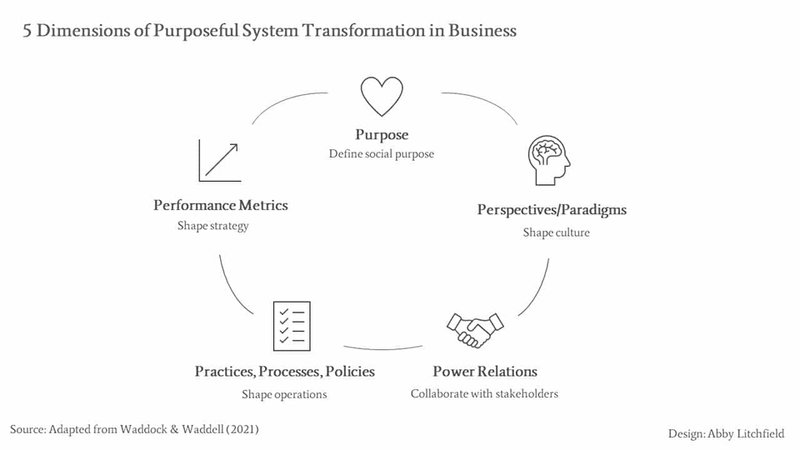INSIGHT
5 ways companies can transform to social purpose
A 5-part framework shows how companies can adopt social purpose. Lafarge Eastern Canada has used it to guide transformational change, write Sandra Waddock and Coro Strandberg
Sandra Waddock is the Galligan Chair of Strategy and Professor of Management at Boston College’s Carroll School of Management. Coro Strandberg is lead advisor of Canada’s United Way Social Purpose Institute. They’ve written this article with The Network for Business Sustainability.
What is social purpose
Too many companies still understand their purpose — or fundamental reason for existence — as maximizing profits or shareholder wealth. How can they move beyond that narrow definition of purpose, towards defining how their businesses help address society’s challenges?
One of us (Coro) helped establish Canada’s United Way Social Purpose Institute. The organization helps companies create a pathway to business and societal success by articulating and scaling social purpose — not just financial purpose. The other of us (Sandra) has co-developed a five-part framework that provides a model for companies moving toward transformation.
In this article, we describe this framework and provide a case study of how Lafarge Eastern Canada has moved toward social purpose.
5 ways to foster social purpose transformation
Shifting to social purpose requires a transformation process that is not easy to accomplish. In addition to defining a social purpose, those who lead such a transformation must change their paradigms or perspectives (view of the world), so that they can understand both the changed purpose and the reasons for it. Then, companies need to implement performance metrics that support the full transformation.
Purpose, paradigms, and performance metrics are three of five core dimensions of any system —including any organization — that need to change for that system to transform. In a paper titled Five Core Dimensions of Purposeful System Transformation, Sandra and co-author Steve Waddell argue that addressing these five core dimensions, the “5Ps,” can be a way to make a complex and difficult task more doable.
The graphic shows the 5Ps applied to social purpose.

The three Ps of purpose, paradigms (or perspectives), and performance metrics are the overarching framework that helps define a system and its relationship to stakeholders and the world.
The three Ps of purpose, paradigms (or perspectives), and performance metrics are the overarching framework that helps define a system and its relationship to stakeholders and the world. Then, these three collectively influence the other two Ps: practices (how work gets done) and power relations (how a company handles its stakeholder relationships).
Sound complicated? It’s actually about the fundamentals.
- A company defines its social purpose as the reason it exists.
- Leaders embed their purpose in their culture or paradigm.
- They pursue a business strategy designed to achieve the purpose
- The strategy gets turned into goals, targets, and performance metrics that fold into incentive systems and governance and management practices.
- The company collaborates with stakeholders on mutually beneficial purpose-driven goals, affecting their power relations.
Let’s see how one company uses these dimensions to change.
Lafarge Eastern Canada shifts to social purpose
Lafarge Eastern Canada, a member of the Swiss-based Holcim Group, is the nation’s largest provider of sustainable construction materials, along with Lafarge Western Canada. Eastern Canada Leadership Team has worked with Coro at the United Way Social Purpose Institute (UWSPI) and pivoted towards a new purpose: ‘To build progress for people and the planet.’
As Lafarge recognizes there are negative environmental impacts in its industry sector, the company’s purpose positions it to invest in innovations to bring positive impacts to people and planet, where over time it can become a stronger force for good.
Indeed, at UWSPI we believe companies like Lafarge Eastern Canada that are driven by social purpose will gain competitive advantage, be able to navigate today’s turbulent business environment, and simultaneously contribute to a better world.
5 steps to social purpose transformation
Here’s how Lafarge Eastern Canada has used the “5Ps” of the framework to guide its transformation.
1. A definition of social purpose
Social purpose at Lafarge means ‘creating a world where people, profits, and planet go hand in hand,’ and where the company understands that there can be no shareholder value without recognizing and benefiting their stakeholders and the natural environment. Thus, the company has four social purpose foci: climate, circular economy, water & nature, and people & communities.
Strategically, the company now orients towards developing innovative sustainable building materials through its targeted research capabilities, with a goal of industry leadership around carbon emission reduction and moving towards low-carbon and circular construction processes.
2. Purpose-driven performance metrics
The social purpose requires new ways of assessing performance, too, including the company’s pledge to attain net zero carbon emissions. In its corporate scorecard, Lafarge Eastern Canada has set four financial performance metrics and four environmental performance metrics, addressing biodiversity, waste recycled into products (circularity), freshwater withdrawal, and carbon emissions. A “people and communities” performance metric is in development.
With purpose-driven performance metrics, Lafarge pays attention to — and measures — impacts and outcomes beyond the purely financial, ultimately generating strong and consistent financial results.
The rationale for shifting performance metrics is simple: you get what you measure. If a company is concerned only about profits, then everything that happens will be geared to producing those profits. In the interest of ‘efficiency’ to maximize profits, for example, companies might rapidly deplete precious assets simply to improve the short-term bottom line.
With purpose-driven performance metrics, Lafarge pays attention to — and measures — impacts and outcomes beyond the purely financial, ultimately generating strong and consistent financial results.